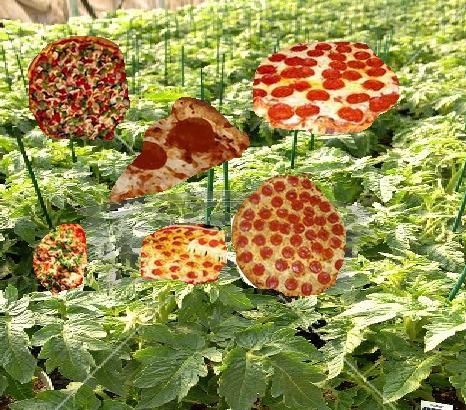Spring Planting

FINALLY! Winter has ended and spring is here. Time to plant the garden! Gardeners the world over look forward to planting time and the promise of a long bountiful growing season followed by a lush harvest of nature’s gifts. What could be more satisfying, more in tune with nature?
I spent the entire weekend planting my garden. My hands are chapped and dried out. My fingernails are so encrusted with rich fertile soil I don’t think they’ll ever be clean again. BUT the garden is in and nature is beginning to work its annual miracle. This year, in addition to the traditional tomatoes, carrots, cucumbers, kale and squash, I tried a few new plantings just to experiment…
The southern border of my garden is now lined with a beautiful row of spaghetti trees. These were imported (at great expense) from the prime spaghetti growing orchards of Tuscany. Although the trees are young, I expect a crop even this first year. It’ll probably be capellini – the finest and most delicate form of spaghetti, often referred to as “angel hair.”
In later years, as the trees mature, they’ll go through all of the forms of spaghetti including vermicelli, spaghettini, spaghetti, linguini, and fettuccini. Beyond this, they will continue to mature and produce rotini and penne. The method of pruning and training the trees has a great deal of influence on which forms of pasta the mature trees will produce. I’m looking forward to many tasty years to come.
In an attempt to make a few extra bucks, I planted a half dozen brake shoe bushes. Some of the earliest products of this versatile plant are just the right size for small cars. As the shoes grow and mature, they get bigger and tougher so, by the end of the season, you can harvest a fine crop of heavy-duty truck brake shoes if you have the patience to wait long enough. I expect to sell my entire harvest to a local auto parts store.
High on the list of every gardener is pest control. I’ve noticed a big increase in the number of stray dogs in the neighborhood and I’m worried about them damaging my garden. Fortunately, Mother Nature herself offers an appropriate remedy. I’ve planted a number of Venus dogtrap plants at random throughout the garden. This voracious man-eating plant is a variant of the famous Venus flytrap. You might say it’s a Venus flytrap on steroids. It grows about three feet tall and produces a big pod-like appendage, which lies open on the ground looking like a large ornamental flower. This plant’s sense of smell is phenomenal. It can smell a dog 40 feet away.
As the dog gets closer, the plant begins to give off the scent of freshly ground hamburger. The dog, intrigued by the wonderful smell, wanders up to the plant in hopes of a tasty meal. Unfortunately, the dog itself ends up becoming a meal as the plant snaps shut, devouring the dog in one lightning-fast bite. A month later the bloom opens up ready for another meal. I can’t wait to see what happens to the stray dog population once these babies reach maturity.
Another new plant I’m introducing to the garden this year is the French fry bush. This is a relatively new plant to the area. It grows slowly at first and reaches maturity only in the hottest part of the summer, and only after having been “watered” with a goodly quantity of hot frying oil. Then, at the hottest part of the day, you can go out and harvest basketfuls of the nicest, crispiest, most tender and tasty French fries you’ve ever had. They’re even better than McDonald’s!
An appropriate companion to this plant is the catsup Fern, which produces those cute little foil packets of catsup just perfect with your freshly harvested fries. They’re also a lot of fun to put down on the sidewalk and STOMP on!
I had a large unused field out back behind the shed that’s never been much good for growing anything – the soil is just too rocky. Then I heard about the newly developed pizza vine. These amazing plants will grow in the poorest soil imaginable and produce a dense harvest of tasty 12-inch pizzas.
Exactly what kind of pizza they bear depends on how they’re fertilized. Popular choices of fertilizer include pepperoni, mushrooms, Italian sausage, onions, green peppers, ham, olives, and a variety of cheeses. It’s a good idea to have a few extra cats around when you’re fertilizing with cheese, because there’s no telling how many mice you might attract. It’s also important to remember to never walk downwind of a pizza vine during a high wind. Sometimes the fruits will get blown off the vines and whiz through the air like a high-speed Frisbee. Getting hit in the face by one of these is NOT a pleasant experience.
Everybody likes dessert and I’m no exception. This year I’ve planted a special dessert garden. I probably got a little carried away with the size and variety of plants, but I’m sure everything will get eaten. I’ve included pie trees (apple, cherry, pecan, and lemon meringue); cake bushes of every flavor; ice cream vines, which have been grafted to produce related frozen treats like sherbet, Popsicles, frozen yogurt, and Sno-cones; and some ground covers like cherry and peach cobbler. Next year I might expand this garden to make a little money on the side. Can you imagine the marketing potential for custom grown wedding cakes?
Of course, if you’re going to plant a dessert garden, it has to be located at the very farthest end of the garden plot. This accomplishes two things. One, it forces you to carry all the sugar you’re going to need to fertilize the dessert plants as far as possible. The extra exercise this creates will practically compensate for the effects of grazing in the dessert garden. The second, and most important, reason to locate the dessert garden far away is to demonstrate to your kids that they don’t get dessert unless they first make their way through all the vegetables.
I am nothing if not a great educator.
See ya around,
Buck



